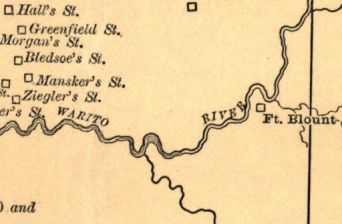Kasper Mansker
Kasper Mansker (1750–1820) was a longhunter and one of middle Tennessee's first European explorers and settlers.[1] He was born of German parents on a ship bound for the new world about 1750. His parents settled in America, but due to poor recordkeeping there are vague and conflicting reports about exactly where they lived. He probably lived in the mid-Atlantic region. Various reports include mentions of Pennsylvania, Virginia, and possibly what is now West Virginia. However, Mansker was a true frontiersman and soon left Virginia to explore the vast lands to the west. It is also known that Mansker married an Elizabeth White of Berkeley County, West Virginia, but there is no known record of the marriage, so details of the actual date and location are also sketchy.[2] In his will a brother George is also mentioned as well as his brother's sons.
In 1769, Mansker departed on his first hunting trip into the vast western territory. He explored and hunted extensively along the Cumberland River in middle Tennessee and Kentucky. He spent most of his adult life exploring, hunting and living in the areas of what are now Kentucky, Tennessee, Georgia, and Mississippi. His first trip was filled with adventures of the hunt, survival, and his party was robbed of some of its supplies by a small band of Indians. In contrast, the French fur traders they met were friendly and his hunting party was able to trade for fresh food and alcohol.
In 1771, Mansker made a second trip into the areas of Kentucky and Tennessee with Col. John Montgomery. This trip was marred by the disappearance of two members of their party who had remained at the camp in Kentucky while additional supplies were being acquired. He eventually set up camp along the Cumberland River in Sumner County, Tennessee. There was an ample supply of game and fertile valleys. Once again Indians attacked their camp and plundered supplies and took about 500 deer skins. These were eventually replaced, but in 1772, an ideal hunting area was identified by Mansker containing two salt licks located close to each other. Hunting was excellent, and Mansker eventually built a fort for himself and his neighbors at this site, near what is now Goodlettsville, Tennessee, in 1780. The fort was an important stopping place for settlers who arrived in middle Tennessee during the late 18th century until the early 19th century.
In 1773, Mansker returned to his home to Virginia, and his name appears in court documents as serving jury duty and appearing as a witness in a separate case. His stay in Virginia was brief, because by 1775, he returned to middle Tennessee to the vicinity of Mansker's Lick. It was during this trip that he explored the section of the Cumberland River near the Red River with John Montgomery at the site of modern Clarksville, Tennessee.
The years of the American Revolutionary War are quiet concerning Mansker, but in 1779 he joined Captain James Robertson's party that was looking for suitable territory to establish a settlement. The area they met was called French Lick, the site of what is now Nashville, Tennessee.

In early 1780, Mansker moved further north and established his own fort at Goodlettsville. He was also a signer the Cumberland Compact, an agreement providing guidelines for the forming of government in the developing Cumberland region. The compact established the Cumberland Association, a governing body for the region made up of representatives from the various forts, about seven, in the vicinity of Nashville. Mansker's fort is one of the forts that was designated for representation.
Soon the Indians realized that the constant push of settlers was unending. The primary concern was the invasion of lands that were recognized among the various Indian tribes as hunting lands. So, the arrival of settlers into this preferred hunting grounds was seen as unacceptable. The result was a series of frequent attacks by the native Indians against settlers in the region. Due to his skill and experience in this area, Mansker's fort was considered to be one of the safest areas in the region. He set up accommodations at the fort and is regarded as one of the earliest innkeepers in the Cumberland settlements.
In the spring of 1781, Mansker became a victim of an Indian attack, and was listed as wounded in the skirmish. This is the only record of him being injured due to conflict with the local Indian tribes.
Notes
- ↑ West, Carroll Van. "Kasper Mansker". Tennessee Encyclopedia of History and Culture.
- ↑ Durham, Walter (Summer 1971). "Kasper Mansker: Cumberland Frontiersman". Tennessee Historical Quarterly 30 (2): 154–77. Retrieved 13 August 2012.
References
- Durham, Walter T. "Kasper Mansker: Cumberland Frontiersman." Tennessee Historical Quarterly Vol. 30, No. 2, (1971): pp. 154–77. <http://www.mansker.org/history/durham.htm>
- Van West, Carroll. "Kasper Mansker" Tennessee Encyclopedia of History and Culture. 21 February 2011. <http://www.tennesseeencyclopedia.net/entry.php?rec=830>